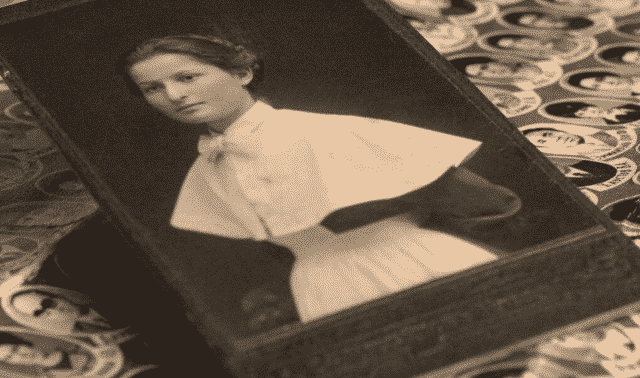Sign up for the Family Tree Newsletter! Plus, you’ll receive our 10 Essential Genealogy Research Forms PDF as a special thank you.
Get Your Free Genealogy Forms
"*" indicates required fields
There are compelling photographs in every family collection that contain a mystery. In New Zealander Dafanie Goldsmith’s family, there is this portrait of a woman in mourning with a haunting expression on her face. She looks so lost that you want to know more about her. In 1904 her great-great-grandfather wrote a letter in which he identified the portrait as his daughter Emily’s maternal grandmother. But is the information in the photograph consistent with the family data?

The genealogical information on this side of the family is incomplete. What’s known is that Emily Pinker was born in 1858 and her mother, Emma Street, was born in 1829. The difficult part is that nothing is known about Emma’s mother, the woman in the photograph. Since Emma’s husband Alfred Pinker remarried after her death in England in 1867, it can be assumed that this portrait of Emma’s mother was taken in England. According to the International Genealogical Index (IGI), there is a baptism for Emma Street, father William and mother Hannah at Sudbury, Suffolk in 1829 and a marriage between a William Street and a Hannah Chamberlain on Jan. 9, 1827. Unfortunately it is difficult to tell if this data pertains to the portrait.
In addition to the portrait being unidentified, there is a question of why the woman is in mourning. There is no doubt that this photo was taken within the first year of the death of her husband. Every item she is wearing is dark, including her collar and cuffs. This extreme lack of color would be worn for at least the first year after her husband’s death. She is wearing a bonnet with a full veil from the late 1840s to 1850 that sits back on the crown of her head with decorations on the lower half the bonnet. Her hair is looped down over her ears in the style of the period. Her dress is rather elaborate with a full cape, beaded dress collar, gloves, watch with a small key, matching bracelets and a parasol. Indeed, every detail is clear indication of upper-class economic status.
Similar types of images appear in the auction catalog of the David Feigenbaum Collection of Southworth & Hawes from Sotheby’s, April 27, 1999. Southworth and Hawes were well-known Boston daguerreotypists. Given the date of the costume and mat (not shown here), it is apparent that this is a high quality daguerreotype probably taken in England. There are no markings on the image to suggest the identity of the daguerreotypist. A daguerreotype is the earliest type of photograph. It is an image on a polished metal surface that must be held at a particular angle to view the picture. They were popular throughout the 1840s and 1850s.
If this is Emma Street’s mother, her birth date would be approximately 1809, and in this portrait, taken circa 1850, she would be 41 years old. It is a likely identification since Emma’s father Alfred had the image and possibly knew the woman in the portrait. However, there are many genealogical mysteries that remain: why did Emily’s grandfather bring a photograph of his deceased wife’s mother with him to New Zealand? Also, there is so little known about the reasons for the immigration from England to New Zealand and about the particular family members that immigrated. It is possible that his in-laws were already living there when he arrived. Another unknown is the name of the woman’s husband, which may be found with a little research in English records.
Learn more about Maureen by visiting her website.




